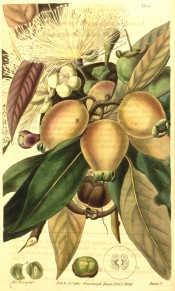Eugenia jambos L.
Tree with lance-shaped leaves and terminal clusters of white flowers followed by ovoid, yellowish-white, fragrant fruit, used in confectionary. To 10m. [RHSD, Hortus].
Horticultural & Botanical History
‘The Rose-Apple, a native of the East Indies, is one of the commonest garden-trees of Madeira : but there is scarcely another that combines so eminently the beauties of flower, fruit, and foliage. The delicate white tassel-like bunches of flowers, contrasting with the thick, dark foliage, enliven the trees from February to July or August, when the fruit is principally in season. The fullest bloom, however, is in March or April; and just after this, the trees are beautifully enriched by the fine cinnamon-coloured or reddish young leaves or shoots. Nothing can exceed the lovliness and delicate appearance of the fruit; its rich clusters half hidden by the dark, thich tufts of foliage, which clothe the outer branches: but though one or two may be eaten with some relish, the over-powering perfume and taste of rose-water, together with the want of juice or dryness, render it generally unpalatable; and it is entirely excluded, except to satisfy occasional curiosity, from the table or dessert. It is produced in the greatest profusion, but used for no other purpose than sometimes to feed the pigs, which eat it greedily.’ [BM t.3356/1834].
History at Camden Park
Received per the ‘Sovereign’ in February 1831. [MP A2948]. It is listed in the 1830 edition of Conrad Loddiges & Sons plant catalogue, a copy of which is held at Camden Park [CPA] and this is a possible source. There is no other record of this plant.
Notes
Eugenia jambos Blanco (1837) = Syzygium malaccense (L.) Merrill & Perry, which see.
Published Mar 27, 2009 - 04:29 PM | Last updated Mar 29, 2010 - 03:44 PM
| Family | Myrtaceae |
|---|---|
| Category | |
| Region of origin | East Indies |
| Synonyms |
|
| Common Name | Rose Apple |
| Name in the Camden Park Record | Eugenia jambos |
| Confidence level | high |


